- Home
- Hermann Hesse
Soul of the Age Page 2
Soul of the Age Read online
Page 2
Then in 1916, while Hesse was under the strain of his relief work as well as the attacks in the German press, his father died, and Mia succumbed to a gradually worsening schizophrenia that eventually necessitated her institutionalization. As a result of these pressures Hesse decided, toward the end of that year, to put himself in the care of Dr. Josef B. Lang, a young disciple of C. G. Jung, in a sanatorium near Lucerne. The experience of psychoanalysis, which extended through some sixty sessions into 1917 and led to Hesse’s acquaintance with Jung himself, struck Hesse less as a revelation than as a systematized confirmation of insights he had gleaned from the great works of literature. (He analyzed his attitude carefully in several essays collected in the volume My Belief: Essays on Life and Art.) Above all, Hesse learned through psychoanalysis to rise above the conventional notions of right and wrong that had oppressed him ever since his Pietist childhood and to acknowledge the legitimacy of all human impulses. Instead of forcing his thoughts and emotions into patterns prescribed by society, he learned to accept what he called the “chaos” of his own consciousness, where the boundary between good and evil did not seem so clearly defined as in Judeo-Christian ethics. The immediate product of this psychic release was the novel Demian, which Hesse wrote in a few weeks late in 1917. The radical ethical ideas of the novel were formulated more systematically in his two essays on Dostoevsky included in the volume In Sight of Chaos (1920). Lang remained Hesse’s friend until his death in 1945 and crops up in Hesse’s letters and narratives under the pseudonyms “Longus” and “Pistorius.”
Demian (1919) was published shortly after the war under the pseudonym of its narrator-hero, Emil Sinclair, because Hesse did not wish to be identified with what he now called his “sentimental-bourgeois” works. The deception was so effective that the book received the Fontane Prize for first novels. When the deception was exposed Hesse returned the prize—but not before he had succeeded in winning a new audience with his new authorial persona. By the time the novel appeared Hesse had made a radical break with his own past. In October 1918, just two weeks before the end of the war, he was finally forced to put Mia in a mental hospital. The following April, having wound up his affairs in Bern, he left his sons in the care of friends and moved to southern Switzerland—in order, as he wrote a correspondent that summer, “to survive and heal my private collapse and to attempt on a small scale what Germany must accomplish on a large scale: to accept what has happened, not to shove the guilt onto others, but to swallow it and say yes to destiny.” Here in the Casa Camuzzi, a Baroque hunting lodge in the village of Montagnola, above Lugano, where Hesse was to spend the rest of his life, he experienced what he later regarded as the happiest and most productive year of his life. In a surge of activity he wrote several important essays, including “Zarathustra’s Return” (an appeal to German youth, calling for spiritual rebirth and published under the pseudonym of Emil Sinclair), two of his finest novellas—Klingsor’s Last Summer and Klein and Wagner—and began the novel Siddhartha. In the company of the artists who now constituted his main society—Louis Moilliet, Karl Hofer, Hans Purrmann, Cuno Amiet, and others—he even toyed with the idea of becoming a painter. In any case, watercolor painting became an increasingly important avocation and, indeed, a significant source of income in the twenties (see the letter to Cuno Amiet of January 5, 1919), when the inflation of the German mark forced Hesse for several years, despite the success of his writings, to live from hand to mouth.
The year that followed the liberating euphoria of 1919 was “probably the most unproductive of my life, and thus the saddest,” Hesse noted in his “Diary of 1920.” In the lull that followed the frenzy of creativity he filled his time with other and more routine activities. With the monthly journal Vivos Voco, which he founded and coedited with Richard Woltereck from 1919 until 1921, Hesse continued the cultural criticism that had occupied him during the war, attacking among other things the resurgent anti-Semitism that, to his dismay, he noted in postwar Germany. The creative lull that interrupted the progress of his novel Siddhartha was finally overcome in 1921 by two new factors: his growing attachment to the singer Ruth Wenger, and a series of therapeutic interviews with C. G. Jung, whom Hesse visited in Küsnacht. In 1922 Siddhartha was completed and published. In early 1924 Hesse was awarded the Swiss citizenship for which he had applied the preceding summer (see his letter of July 26, 1923)—technically, for a restoration of citizenship he had given up as a child—on the grounds that his three sons were Swiss and that the experience of the recent war had taught him that his loyalties lay with his elective country. His divorce from his first wife was granted in the summer of 1923, freeing him for marriage to Ruth Wenger, which took place—despite a growing reluctance evident in the letters of 1922 and 1923—in January of 1924.
While Ruth had been the muse of such works as Klingsor’s Last Summer, Siddhartha, and the charming fantasy Pictor’s Metamorphoses, Hesse’s marriage to the much younger woman seemed misbegotten from the start. Although Hesse was content to spend his winters in Basel and then in Zurich, where Ruth pursued her career and her social activities, his regular return to Montagnola meant long periods of separation, leading in 1927 to a second divorce. During this period, despite all the complaints in his letters about his life of hermitlike solitude, Hesse was actually engaged in a frenzy of activity. His annual trips (since 1923) to the spa at Baden for the treatment of his sciatica (where he always stayed at the hotel Verenahof) and a lecture tour to Germany generated two of his most brilliantly ironic autobiographical accounts, At the Spa (1925) and The Journey to Nuremberg (1927). He wrote a number of essays, edited works of his favorite writers—Jean Paul, Novalis, Hölderlin, and others—and translated medieval Latin tales into German. In 1926, in another of his characteristic bursts of creative activity, he completed Steppenwolf, which appeared the following year simultaneously with a biography by his friend Hugo Ball that had been commissioned for his fiftieth birthday. Yet the mood of despondence that characterized those years was blatantly evident in the bitter poems published in 1928 under the title Crisis: Pages from a Diary.
In 1927 Hesse immediately set to work on his next novel. That same year he met an admirer with whom he had been corresponding since her teens, the art historian Ninon Dolbin, née Ausländer (1895–1966). Narcissus and Goldmund (1930) became Hesse’s most successful work during his own lifetime. And in 1931 Hesse married Ninon and moved with her into a new house in Montagnola, built for them by his friend and patron Hans C. Bodmer, where they were to spend the remainder of their lives. The fruit of Hesse’s new happiness and security was the story The Journey to the East (1932), in which he paid cheerful tribute to his friends (“Ninon, known as ‘the foreigner’” [her maiden name: Ausländer], “Louis the Terrible” [Louis Moilliet], “Longus” [J. B. Lang], and others), to his cultural icons, and even to figures from his own works.
Hesse’s last novel, The Glass Bead Game, was originally to have been the story of “a person who lives through the great epochs of human history in several reincarnations,” as he put it in a letter to Rudolf Pannwitz (January 1955)—a series of parallel lives beginning in prehistoric times, running through the Golden Age of India, the patristic period of early Christianity and eighteenth-century Pietism in Germany, and ending in a pedagogical province in the future. But in the course of its eleven-year genesis, from 1931 until the novel’s publication in 1943, Hesse’s intentions gradually shifted under the impact of current events. Barely had Hesse and Ninon become established in their new house in Montagnola when, in the spring of 1933, the first wave of emigrants fleeing Hitler’s Germany reached their threshold. Hesse had resigned from the Prussian Academy of Arts two years before Hitler’s rise to power, for reasons that he explained in his letter of November 1930 to Wilhelm Schäfer. From that moment on Hesse was involved, as he had been during the first world war, in the support of those overrun by political events. In 1934 he joined the Swiss Writers’ Union so that he would be in a better position to provide assi
stance and to intervene on behalf of needy émigrés. Again, however, as had been the case twenty years earlier, he experienced abuse from voices in Germany, as well as from other countries, who were dissatisfied by the efforts of the Swiss citizen to maintain the politically neutral position that he justified in his letter to Arthur Stoll of September 17, 1933.
Unlike many opponents of the Nazis, Hesse was permitted for a good many years to continue publishing his works in Germany. Indeed, when Hesse’s publisher, S. Fischer, moved abroad with many of the firm’s authors, the National Socialists did not permit Hesse’s copyrights to leave Germany. (The rights remained with the “Aryan” branch of S. Fischer, which was managed in Berlin by Peter Suhrkamp until his arrest by the Gestapo in 1944.) For those reasons Hesse came in for abuse from various émigré writers who felt that he had not spoken out publicly against Hitler and that he should have refused to allow his works to appear in Nazi Germany. It was Hesse’s position, however, that he could do more good by continuing to make his voice heard within Germany since he was one of the few writers not co-opted by the Nazis who could still be published there. And that circumstance continued until 1939, when the Nazis finally declared his works undesirable and denied their publication by the indirect method of refusing paper for their printing.
During the same period, Hesse began in 1935 to review German books for the Swedish literary journal Bonniers Litterära Magasin—an opportunity he exploited in order to make known abroad a host of works, including notably those of Kafka and other Jewish writers, that were ignored by official German propaganda organs. It was this activity that drew upon Hesse the disapproval of Will Vesper, a Nazi spokesman who was piqued in part, no doubt, by the fact that Hesse had replaced him at Bonniers Litterära Magasin. (See Hesse’s letter of January 1936 to Wilhelm Schäfer.) That same year brought the death of his brother, Hans, through suicide (as detailed in the letter of December 1935 to his cousin Fritz Gundert). In 1943, finally, the Nazis denied publication rights to The Glass Bead Game, and Hesse published the novel in Switzerland. This circumstance not only deprived Hesse of the basis for his income, it also cut him off from his principal readership and, hence, the opportunity to make his voice heard in Nazi Germany.
Hesse’s home in Montagnola, where he found solace tending his garden, became the place of first refuge for many émigrés—including Thomas Mann, the socialist publicist Heinrich Wiegand, and the writer Peter Weiss. And Hesse gave financial and personal support to dozens of others. Montagnola represented for scores of Germans a reservoir of traditional German values that were being trampled underfoot by the Nazis. For this reason it is doubly ironic that, immediately after the war, Hesse again, for a brief time, had to experience political attacks by the democratic forces of liberation—this time in the person of Hans Habe, a German émigré serving in the U.S. Army. With the help of such supporters as Thomas Mann and Theodor Heuss, Hesse rapidly set matters aright. But for the third time since the “Cologne Calumny” in 1915, Hesse came to grief for his efforts to maintain his intellectual and ethical independence, as he explained in his letter of October 23, 1945, to Fritz Gundert.
His public vindication came rapidly. In 1946 he received the Nobel Prize for literature for his representation of the classical ideal of humanity and his lofty stylistic values. That same year he was awarded the Goethe Prize of the City of Frankfurt am Main. The remaining years of Hesse’s life were as tranquil as his early years had been tumultuous. To be sure, his correspondence steadily increased: in 1948, he noted, between one hundred and five hundred pages of correspondence arrived daily—letters that he increasingly answered with circular letters that he had privately printed for the purpose (see his 1947 “Response to Letters Requesting Help”) or with personally initialed postcards bearing a watercolor from his brush. For the last twelve years of his life, to escape the importunities of visitors who ignored the sign politely requesting no visitors, he and Ninon spent July and August in Nietzsche’s Sils Maria, where he could meditate and converse quietly with such old friends as Theodor Heuss.
In 1950 Hesse encouraged Peter Suhrkamp, who had courageously maintained the German branch of S. Fischer under the Nazis, to set up his own publishing company, and during the early years Hesse’s works provided the main financial basis for that enterprise. (His Collected Works were published in six thin-paper volumes for his seventy-fifth birthday in 1952, and the seven-volume Collected Works were brought out in 1957 for his eightieth birthday.) In these final years, although he continued to write letters, poems, and personal essays at an astonishing rate despite increasingly poor eyesight, Hesse wrote no further major literary pieces. He lived quietly with Ninon, surrounded by family and friends. He died peacefully in his sleep on August 9, 1962.
* * *
Hesse, like the rest of his family an inveterate paper hoarder, saved some thirty-five thousand letters written to him over the years. However, of the estimated thirty thousand letters that he wrote during his lifetime, only about half have survived. (Until he met Ninon in 1927 he did not routinely keep copies of the letters he wrote.) Most letters from the years up to 1900 are extant because they were sent to his parents and sisters, who threw nothing away. The most important of these have been published in a volume that Ninon Hesse edited in the year of her death, Childhood and Youth before Nineteen Hundred: Hermann Hesse in Letters and Documents 1877–1895 (Kindheit und Jugend vor Neunzehnhundert: Hermann Hesse in Briefen und Lebenszeugnissen 1877–1895 [Frankfurt am Main: Suhrkamp, 1966]). However, little remains from the Gaienhofen years, and the entire correspondence with his first wife, Mia, was lost in a fire. The letters to his second wife were sealed until 1987 and were not available for inclusion in the Collected Letters; while the letters to Ninon remain under seal until the year 2017.
Fortunately, several entire correspondences have been preserved and published separately: the engaging exchange with Thomas Mann, extending from 1910 until Mann’s death in 1955; the correspondence with Romain Rolland, which documents the pacifistic and cosmopolitan efforts of these two men brought together by their opposition to World War I; the disappointingly trivial correspondence with Karl Kerényi and the frank and revealing one with Hesse’s friend, the socialist publicist Heinrich Wiegand; the businesslike communications concerning copyrights, royalties, and details of publication with Peter Suhrkamp; and others. During his own lifetime Hesse published a volume (Briefe, 3rd ed. [Frankfurt am Main: Suhrkamp, 1964]) containing letters of general interest. The four-volume edition of his Collected Letters (Gesammelte Briefe, edited by Volker Michels [Frankfurt am Main: Suhrkamp, 1973–1986]) contains 1,762 letters from the years 1895 to 1962. Altogether, about three thousand, or one tenth, of Hesse’s letters are currently available in German. (Most of Hesse’s manuscripts are housed in the Hesse collections of the Deutsches Literaturarchiv in Marbach and the Schweizerische Landesbibliothek in Bern.)
The present selection, which comprises some three hundred letters taken from the various collections listed above, seeks to be representative. It includes letters from every period, indeed from virtually every year, of Hesse’s life from 1891 to his death in 1962. And it reveals Hesse in every facet of his personality as well as in every modulation of his voice—from the pious posings of the early letters to parents and siblings and the self-dramatizing aestheticism with which he presented himself to school friends, through the increasingly relentless self-exposure of his missives from Gaienhofen, to the often startling frankness of his communications to his psychoanalysts and physicians, the growing circle of writers, musicians, and painters who became the friends of his maturity, the public figures who approached the famous man of letters, and finally the many readers who turned to Hesse over the years for advice and consolation. The unmediated tone of the man emerges from the very haste of the letters, which—at least in the years until 1930—were never intended for publication and which assume that the reader can fill in the examples for the frequent “etc.” that punctuate these lines. The ellipses in
dicated by brackets occur in the German edition and mark omissions to avoid unnecessary repetitions from letter to letter. The notes, which are based on the notes in the German edition, have been revised and supplemented for the needs of readers in the United States.
These letters contain the raw material for the literary works that have drawn millions of readers to Hesse. They reveal the patterns of the writer’s daily life, his reading, his health problems, the expression of his beliefs, his habits of composition. But they also echo the relentlessly honest voice of a man striving for his personal individuation, seeking to maintain a position of integrity in a world grown problematic, and hoping through the miracle of communication to demonstrate his commitment to another human being. We see here the aestheticism of the rebellious youth, the dissatisfactions of the young paterfamilias, the moral ambivalence of the war years, the spiritual awakening that followed, the crisis of Steppenwolf, the withdrawal into the supratemporal realm of The Glass Bead Game, and the ethical tranquillity of the aging Hesse. The life exposed through these letters exemplifies in a very real sense the “soul of the age.”
Theodore Ziolkowski
TO JOHANNES AND MARIE HESSE
[Maulbronn, after September 15, 1891]
You would probably most like to hear about my life at the seminary. Incidentally, the teachers and I are getting along fine; Klaiber is in the infirmary with a swollen foot, they’re taking good care of him there, he’s looking quite rosy.

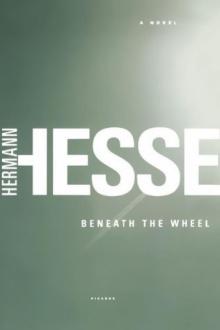 Beneath the Wheel
Beneath the Wheel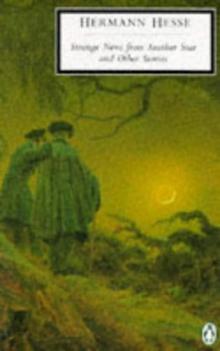 Strange News From Another Star
Strange News From Another Star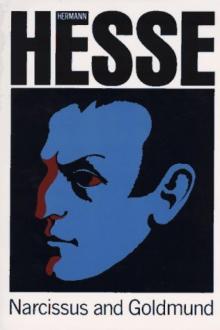 Narcissus and Goldmund
Narcissus and Goldmund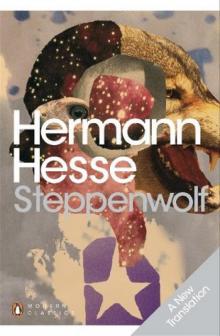 Steppenwolf
Steppenwolf Siddhartha
Siddhartha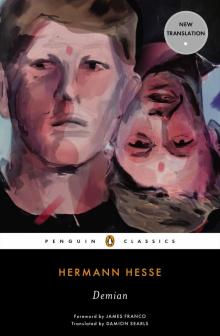 Demian
Demian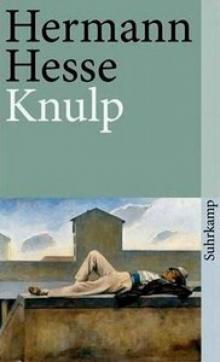 Knulp
Knulp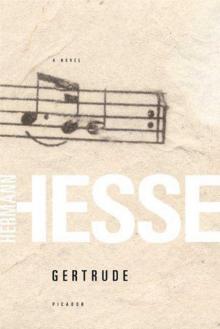 Gertrude
Gertrude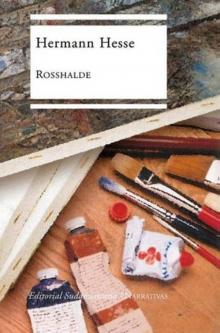 Rosshalde
Rosshalde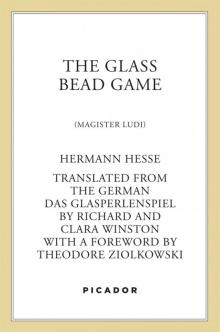 The Glass Bead Game
The Glass Bead Game The Journey to the East
The Journey to the East Klingsor's Last Summer
Klingsor's Last Summer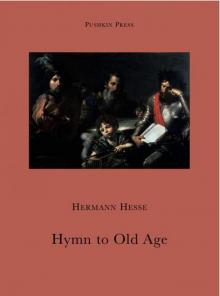 Hymn to Old Age
Hymn to Old Age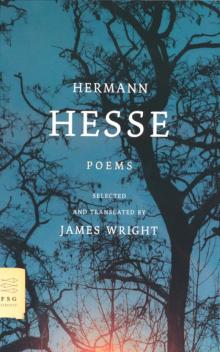 Poems
Poems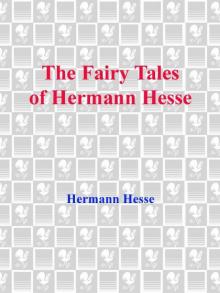 The Fairy Tales of Hermann Hesse
The Fairy Tales of Hermann Hesse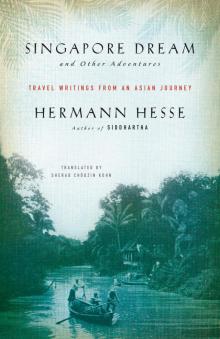 Singapore Dream and Other Adventures
Singapore Dream and Other Adventures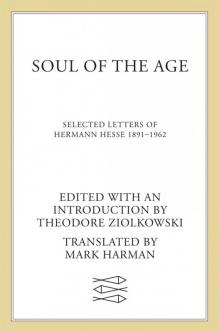 Soul of the Age
Soul of the Age